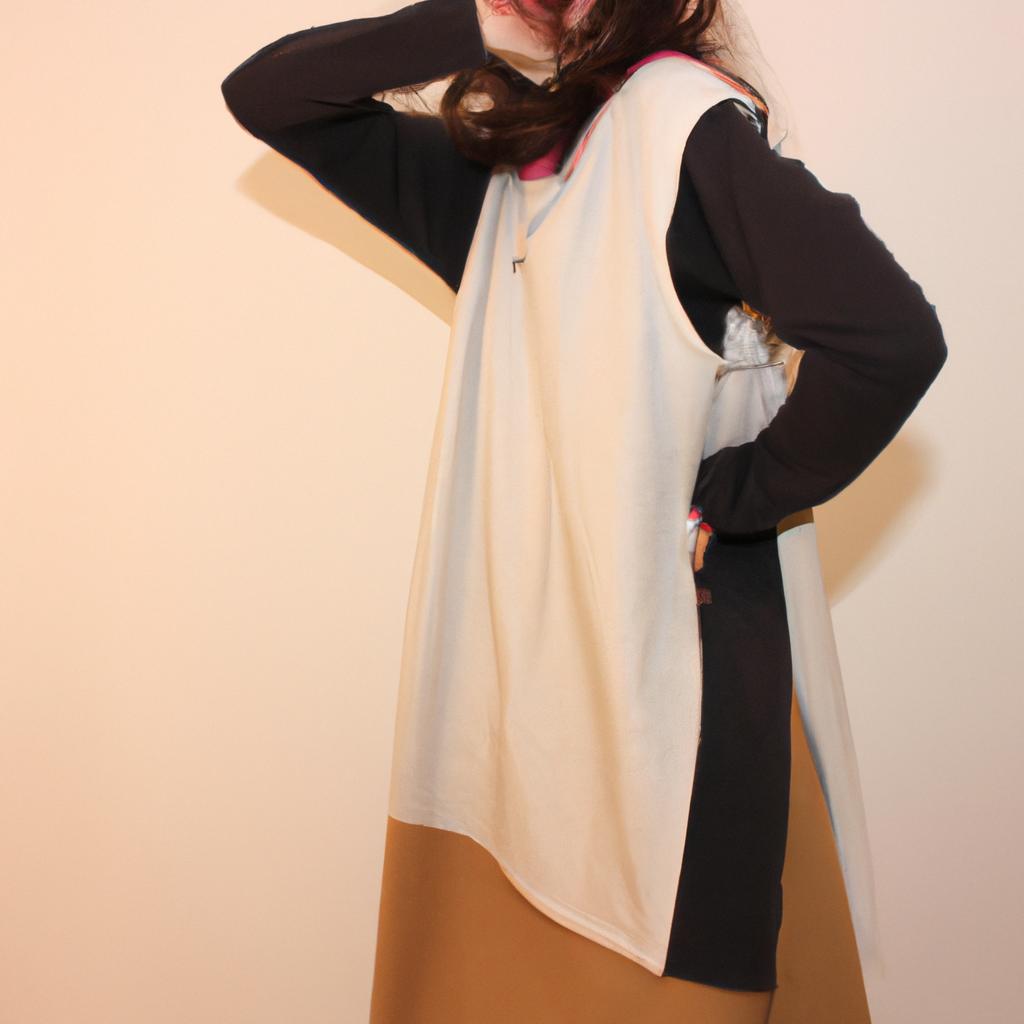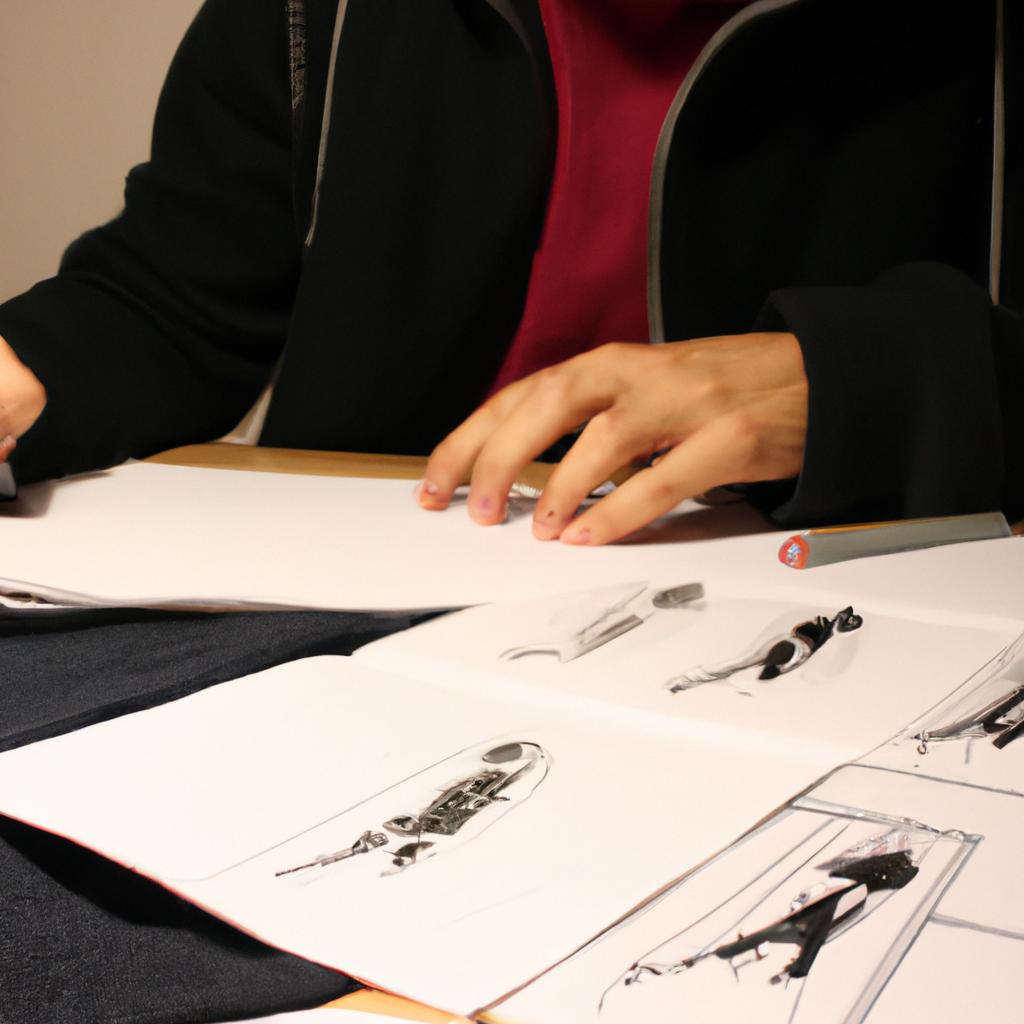Proportions and anatomy play a crucial role in character design within the realm of arts and illustration. The ability to accurately depict human or creature-like figures relies heavily on an understanding of how proportions relate to the overall aesthetic appeal and believability of a character. By employing precise measurements and anatomical knowledge, artists can create visually captivating characters that resonate with their audiences.
To illustrate this concept, let us consider the hypothetical case of a fantasy illustrator tasked with designing a mystical creature for a popular video game. This artist understands that proper proportions are essential in creating an otherworldly being that is both enchanting and plausible within its fantastical context. Through meticulous research and observation, the illustrator delves into studying different animal anatomies along with various cultural mythologies in order to blend elements seamlessly together. By skillfully manipulating proportions, such as elongating limbs or enlarging certain features while maintaining balance and harmony, the artist successfully brings forth a creature that captivates players’ imaginations and enhances their gaming experience.
In this article, we will delve deeper into the secrets behind using correct proportions and anatomy in character design across different artistic mediums. We will explore why these aspects matter so much when it comes to crafting compelling characters, discuss techniques used by professional artists to achieve accurate proportions, and provide practical tips for aspiring artists to improve their own character designs.
Firstly, let’s discuss why proportions are crucial in character design. Proportions refer to the relative sizes and ratios of different body parts or features within a figure. When these proportions are off, a character can appear distorted or unrealistic, which can undermine its visual impact and believability. For example, if a humanoid character has abnormally long arms compared to the rest of its body, it may look awkward or unbalanced.
Accurate proportions also contribute to the overall aesthetic appeal of a character. The human eye is naturally drawn to balanced and harmonious forms. By adhering to proper proportions, artists can create visually pleasing characters that resonate with audiences. This principle applies not only to human characters but also to creatures or fantastical beings that still need to maintain a sense of anatomical credibility.
Professional artists employ various techniques to achieve accurate proportions in their character designs. One common approach is using reference material such as photographs, anatomy books, or even live models. By studying real-life references and understanding how different body parts relate to each other in terms of size and position, artists can create more realistic and believable characters.
Another technique is employing basic measurement systems like the “head-to-body” ratio or the “eight-heads-tall” rule for human figures. These guidelines help ensure consistent proportions across different poses and perspectives.
Additionally, considering the character’s intended role or story context plays a significant role in determining appropriate proportions. For instance, heroic characters may have exaggerated muscular builds while delicate or mystical characters might have more slender frames.
Lastly, practicing gesture drawing and quick sketching can greatly improve an artist’s ability to capture accurate proportions on-the-fly. These exercises help train the eye-hand coordination required to quickly capture the essence of a pose before refining it further.
In conclusion, understanding proper proportions and anatomy is essential for creating compelling and believable characters in art and illustration. By employing precise measurements, studying reference material, and considering the character’s context, artists can create visually captivating figures that resonate with audiences. So whether you’re an aspiring artist or a seasoned professional, remember to pay attention to proportions and anatomy in your character designs to bring your creations to life.
Understanding Proportions and Anatomy
Imagine a skilled artist meticulously sketching the outline of a figure, capturing its essence with every stroke. As they delve deeper into their work, it becomes apparent that the secret lies in understanding proportions and anatomy. By carefully mastering these aspects, artists are able to breathe life into their characters, making them believable and relatable.
Proportions serve as the structural foundation upon which character design is built. They determine the overall shape and size of each body part relative to others, creating balance and harmony within the composition. For instance, consider a hypothetical scenario where an artist intends to depict a heroic warrior. If the proportions are accurately portrayed—broad shoulders, powerful limbs—they convey strength and dominance. Conversely, incorrect proportions might unintentionally portray fragility or clumsiness, diminishing the desired effect.
To illustrate further how crucial proportions are in character design, let us explore four key reasons why they play such a vital role:
- Emotional impact: Properly-proportioned characters can elicit specific emotional responses from viewers. A tall and slender figure may evoke elegance or vulnerability, while a robust physique may exude confidence or power.
- Visual storytelling: Through deliberate manipulation of proportions, artists can effectively communicate information about a character’s background or personality without relying on explicit details.
- Audience connection: Well-executed proportions allow viewers to connect with characters on an instinctual level by appealing to their innate sense of familiarity and recognition.
- Suspension of disbelief: Accurate portrayal of anatomical features creates believability in fictional worlds. Even when designing fantastical creatures or beings beyond human imagination, grounding them in realistic anatomical principles helps suspend disbelief for audiences.
In addition to grasping the importance of proportions in character design, understanding human anatomy is equally essential. Artists must have knowledge of skeletal structure, muscle groups’ interactions, and how weight distribution affects posture and movement. This expertise enables them to create dynamic poses that appear natural and fluid.
Transitioning seamlessly into the subsequent section, it becomes evident that mastering proportions is not a mere step in character design but rather a fundamental pillar. By exploring further how these aspects impact the overall quality of character representation, we can uncover the true significance of proportions in creating captivating and compelling visual narratives.
Importance of Proportions in Character Design
Understanding the intricate relationship between proportions and anatomy is crucial in creating captivating character designs in arts and illustration. By skillfully manipulating these elements, artists can breathe life into their creations, making them relatable and visually appealing to viewers.
To illustrate the significance of proportions in character design, let us consider an example: a fantasy creature with elongated limbs and a small torso. This unique proportion immediately captures our attention, evoking a sense of otherworldliness and intrigue. The exaggerated limbs may convey agility or gracefulness, while the smaller torso might suggest vulnerability or fragility. Through this deliberate manipulation of proportions, the artist has successfully conveyed specific characteristics and emotions to engage the audience on an emotional level.
When designing characters, several key factors come into play regarding proportions:
-
Balance: Achieving balance between different body parts helps create harmony within a character’s overall design. For instance, if a character has broad shoulders but narrow hips, it creates visual asymmetry that can emphasize strength or dominance.
-
Proportional relationships: Maintaining realistic proportional relationships among various body parts ensures believability in character design. A table below demonstrates how changing certain measurements influences perceived features:
Body Part Measurement Increase Perceived Change Head Larger Childlike appearance Eyes Wider Innocence or surprise Limbs Longer Elegance or supernatural attributes -
Exaggeration: Intentional exaggeration of certain features can help express personality traits more effectively. An elongated nose may indicate curiosity or nosiness, while oversized hands could imply strength or clumsiness.
By understanding these principles and incorporating them thoughtfully into their artwork, artists can manipulate proportions to evoke specific emotional responses from their audience. Exploring beyond mere anatomical accuracy allows for creative expression and storytelling possibilities, enabling the artist to connect with viewers on a deeper level.
In the upcoming section, we will delve into the role of anatomy in creating characters and how it contributes to their overall design. Through an exploration of anatomical details, artists can further enhance their character’s believability and visual impact.
Exploring the Role of Anatomy in Creating Characters
Transitioning from our previous discussion on the importance of proportions in character design, let us now delve into another crucial aspect that contributes to bringing characters to life – anatomy. By understanding the intricacies of human anatomy and incorporating it effectively into character designs, artists and illustrators can create visually compelling and believable figures.
To illustrate this point, consider a hypothetical scenario where an artist is tasked with designing a superhero character. The artist starts by studying various anatomical references such as muscle structure, bone placement, and joint movements. Through careful observation and analysis, they gain valuable insights into how these elements interact within the human body. Armed with this knowledge, the artist proceeds to craft their superhero character, ensuring that each detail adheres to anatomical accuracy while still embodying the desired characteristics.
The role of anatomy in character design goes beyond mere realism; it also enables artists to convey specific emotions or traits through visual representation. Here are some ways in which anatomy influences character development:
- Body language: Understanding anatomical structures allows artists to depict different postures and gestures accurately. For instance, a hunched back might signify vulnerability or defeat, while broad shoulders can convey strength and confidence.
- Facial expressions: By comprehending facial muscles and their corresponding actions, artists can depict a wide range of emotions convincingly—a raised eyebrow indicating skepticism or a downturned mouth expressing sadness.
- Physical attributes: Anatomical variations contribute to individuality among characters. Incorporating unique features like scars or birthmarks adds depth and backstory to their appearance.
- Age progression: Knowledge of how the body changes over time aids in creating realistic depictions of characters at different stages of life – be it youthfulness characterized by smoother skin or signs of aging like wrinkles and sagging.
By skillfully utilizing these aspects of anatomy, artists enhance not only the authenticity but also the emotional resonance of their characters.
| Aspects of Anatomy | Influence on Character Design |
|---|---|
| Body language | Conveys emotions and traits |
| Facial expressions | Depicts a wide range of feelings |
| Physical attributes | Adds uniqueness to characters |
| Age progression | Reflects the passage of time |
As we have explored the importance of proportions in character design and delved into the role anatomy plays, it becomes evident that these two elements are interdependent. In the subsequent section, we will delve into methods for achieving realistic proportions while considering anatomical accuracy as a vital component.
Building upon our understanding of the significance of proportions and anatomy, let us now explore effective techniques for attaining lifelike depictions in character design.
Methods for Achieving Realistic Proportions
Exploring the Role of Anatomy in Creating Characters
In the previous section, we delved into how anatomy plays a crucial role in character design. Now, let us examine some methods for achieving realistic proportions by emphasizing the importance of understanding anatomical principles.
Consider this case study: an artist is tasked with creating a superhero character who possesses extraordinary strength and agility. To bring this character to life, it is essential to ensure that their physique aligns with their abilities. By studying human anatomy and analyzing the musculature system, the artist can accurately depict well-defined muscles that convey power and movement.
To achieve realistic proportions in character design, here are key factors to consider:
-
Scale and proportion: Understanding how different body parts relate to one another is fundamental in creating visually appealing characters. Proportions should be consistent throughout the entire design, ensuring harmony between various body features.
-
Form and volume: The ability to render three-dimensional forms convincingly adds depth and realism to characters. Artists must grasp concepts such as foreshortening and perspective to accurately portray objects or figures at different angles.
-
Gesture and pose: Capturing dynamic poses enhances the overall appeal of characters, adding energy and storytelling elements to illustrations. A knowledge of gesture drawing helps artists create more expressive and engaging compositions.
-
Characterization through details: Paying attention to subtle characteristics like facial expressions, hand gestures, clothing folds, or even scars can contribute greatly to conveying personality traits and enhancing visual storytelling.
| Achieving Realistic Proportions | |
|---|---|
| 1 | Study human anatomy |
| 2 | Understand scale and proportion |
| 3 | Master form and volume |
| 4 | Emphasize characterization |
By employing these techniques effectively, artists can breathe life into their characters while maintaining believability within their artistic worlds.
Utilizing Anatomy to Enhance Character Expressions, we will explore how understanding anatomical structures can amplify the emotional impact of character designs.
Utilizing Anatomy to Enhance Character Expressions
By understanding the intricate details of the human body and incorporating them into our illustrations, we can create dynamic characters that evoke emotion and captivate viewers.
Character design is not solely about creating aesthetically pleasing figures; it also involves conveying emotions and narratives through visual representation. For instance, imagine a character with slumped shoulders, downturned eyes, and clenched fists. These physical traits instantly communicate feelings of sadness or despair to the audience, without any need for explicit explanation. By studying anatomy and its impact on facial expressions and body language, artists can effectively portray various emotions in their work.
To better grasp the relationship between anatomy and character expression, consider the following key points:
- Facial Anatomy: The face serves as a canvas for expressing an array of emotions. Understanding the underlying anatomical structures such as muscles, bones, and ligaments allows artists to accurately depict different expressions like joy, anger, or surprise.
- Body Language: A character’s posture speaks volumes about their personality and current state of mind. Artists can utilize knowledge of skeletal structure and muscle groups to convey strength, vulnerability, confidence, or fatigue through a character’s stance.
- Gesture Drawing: Capturing fluidity and movement in character designs requires mastery of gesture drawing techniques. This approach emphasizes capturing essential lines of action that reflect natural poses and actions by focusing on simple yet impactful gestures.
Table example:
| Emotion | Facial Expression | Body Language |
|---|---|---|
| Joy | Smiling lips | Upright posture |
| Anger | Furrowed brow | Clenched fists |
| Surprise | Wide-open eyes | Raised eyebrows |
By intertwining these aspects within our artistic process using reference materials such as photographs or life drawing sessions—artists gain a deeper understanding of proportions and anatomy. This knowledge enables them to create stunning character designs that are visually engaging and emotionally resonant.
In the subsequent section, we will delve into advanced techniques for mastering proportions and anatomy in character design. By applying these principles effectively, artists can elevate their creations to new heights, capturing both realism and imagination simultaneously.
Mastering Proportions and Anatomy for Stunning Character Designs
Transitioning from the previous section on utilizing anatomy to enhance character expressions, we now delve into the profound impact of proportions in creating captivating character designs. By understanding and mastering the principles of proportionality, artists can breathe life into their illustrations, capturing the essence and personality of each character with precision.
Consider a hypothetical example of two characters: one designed with exaggerated features and disproportionate limbs, while the other adheres closely to realistic anatomical proportions. The former character may appear comical or cartoonish, eliciting a sense of playfulness or whimsy. On the other hand, the latter character exudes a more grounded and relatable aura due to its adherence to human-like proportions. This demonstrates how variations in proportions directly influence audience perception and emotional engagement.
To further illustrate this point, let us explore four key ways in which proportional choices impact character design:
- Conveying Strength and Power: Larger-than-life physique and well-defined muscles can evoke feelings of strength and power.
- Instilling Vulnerability: Delicate features, smaller stature, or subtle asymmetry can create an impression of vulnerability or fragility.
- Expressing Emotion: Alterations in facial proportions such as oversized eyes or exaggerated mouths can intensify emotions like happiness or sadness.
- Portraying Age: Adjustments in body proportions such as elongated limbs for youthful characters or stooped posture for elderly figures contribute to conveying age effectively.
Now, let’s examine these concepts through a table that highlights how different proportional choices can shape our interpretation of characters:
| Proportion | Effect |
|---|---|
| Exaggerated Features | Comedic/Playful |
| Realistic Human-Like Proportions | Grounded/Relatable |
| Large Muscles | Powerful/Sturdy |
| Delicate Features/Subtle Asymmetry | Fragile/Vulnerable |
| Oversized Eyes/Exaggerated Mouths | Intensified Emotion |
| Elongated Limbs | Youthful Appearance |
| Stooped Posture | Elderly Representation |
In the realm of character design, proportions serve as a tool to elicit emotional responses and convey narratives. By thoughtfully manipulating these visual elements, artists can create characters that resonate deeply with audiences, evoking empathy or eliciting specific emotions.
Through an understanding of proportionality and its impact on character design, artists possess a powerful means to breathe life into their illustrations and captivate viewers in unique and meaningful ways.
 PSP Oste
PSP Oste



